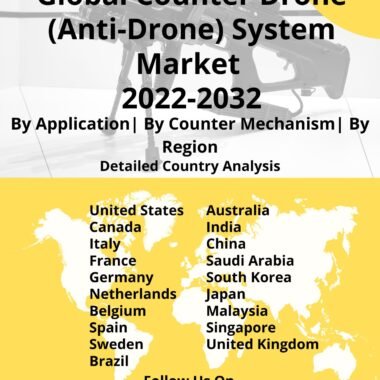Description
Nano And Micro Satellites Market
Frequently Asked Questions of Global Nano And Micro Satellites Market
Nano and micro satellites, also known as nanosatellites and microsatellites, are small spacecraft that are significantly smaller and lighter than traditional satellites. They have gained popularity in recent years due to advancements in miniaturization and cost reduction of satellite components. Nano satellites, often referred to as CubeSats, are the smallest category of satellites. They typically have a mass ranging from a few grams to a few kilograms. The most common form factor for CubeSats is a cube with sides measuring 10 centimeters (1U CubeSat), but variations such as 2U, 3U, 6U, and 12U also exist. Nano satellites are relatively inexpensive to build and launch, making them accessible to universities, research institutions, and even individual enthusiasts.
Micro satellites are slightly larger and more capable than nano satellites. They typically weigh between 10 kilograms and 100 kilograms. Micro satellites can accommodate more advanced payloads and often have greater functionality and capabilities compared to nano satellites. They are used for various applications, including Earth observation, communication, scientific research, and technology demonstration. These satellites can capture high-resolution imagery of the Earth’s surface, monitor environmental changes, track weather patterns, and assist in disaster management. Nano and micro satellites can be used to establish low Earth orbit (LEO) satellite constellations for global communication networks, providing internet connectivity to remote and underserved regions. They can enable scientific experiments in space, studying phenomena such as microgravity, atmospheric conditions, and space weather. Nano and micro satellites serve as platforms for testing new technologies, components, and mission concepts before implementing them in larger satellites or missions.
Compared to traditional satellites, nano and micro satellites can be developed and launched at a fraction of the cost. This affordability enables organizations with limited budgets to conduct space missions and experiments. The small size and simplified designs of these satellites allow for faster development cycles. This rapid turnaround time facilitates more frequent updates and technological advancements. Nano and micro satellites can be deployed in constellations or swarms, working together to achieve common objectives. This approach allows for improved coverage, redundancy, and data collection from multiple vantage points. The accessibility of nano and micro satellites has opened up new educational and research opportunities in the field of space science and engineering. Universities and students can develop their own satellites and gain hands-on experience in satellite design, operation, and data analysis
Major factors driving Nano And Micro Market Growth
The market for nano and micro satellites has experienced significant growth in recent years. The increasing demand for affordable and accessible space-based solutions, along with advancements in miniaturization and commercial off-the-shelf components, has contributed to the expansion of this market.
Trends influencing the Nano-And Micro Market Size
Advances in technology, such as miniaturized components, improved power efficiency, and enhanced communication systems, have expanded the capabilities of nano and micro satellites. These advancements enable more sophisticated missions and data collection, supporting the growth of the market.
Nano-And Micro Market Forecast & Dynamics
The market has seen the emergence of numerous companies specializing in nano and micro satellite manufacturing, launch services, and data analytics. These include established players like Planet, Spire Global, and Astrocast, as well as startups and university-led projects. The micro satellite market forecast encompasses a thorough market analysis and assessment of market size. The analysis comprises an evaluation of regional market size, factors driving growth, constraints, and potential opportunities. Furthermore, the regional analysis also includes an examination of the market size of micro satellite specific to each country.
Nano And Micro Market Development
Kongsberg NanoAvionics (NanoAvionics), a smallsat bus manufacturer and mission integrator, has announced that six of their satellites would be sent into orbit on SpaceX’s next Transporter-8 mission. Tiger-4, owned by telecom operator OQ Technology, will help to expand the world’s first and largest 5G Narrowband-IoT constellation in low Earth orbit (LEO). NanoAvionics’ 6U nanosatellite is the company’s fourth satellite for OQ Technology. Satlantis, a Spain-based developer and manufacturer of “Earth & Universe Observation” payloads for tiny satellites, owns the second satellite, a 16U optical Earth observation satellite called “GEI-SAT.” The satellite is a prototype for a Satlantis remote sensing constellation that will do atmospheric CH4 measurements with high spatiotemporal resolution and simultaneous source emitter localization.
The HawkEye 360 radio frequency (RF) geolocation microsatellite constellation’s Clusters 7 through 11 have been contracted to Space Flight Laboratory (SFL). SFL is designing, assembling, and integrating Cluster 9 at its Toronto headquarters as part of the Flex Production programme, and it is also providing technical support for the integration of Clusters 7, 8, 10, and 11 at HawkEye 360’s new manufacturing site in Virginia. Each cluster consists of three microsatellites. The SFL Flex Production programme, designed with NewSpace firms in mind, allows customers the option of contracting SFL to totally develop the first satellite, or satellite cluster, in a Microspace constellation at its Toronto site. SFL then aids the customer in establishing further mass manufacturing at their own or another location.
The global landscape of nano and microsatellites has seen remarkable growth, transforming the space industry by enabling cost-effective and versatile solutions for various applications. Nano and microsatellites, characterized by their smaller size and lower mass, have become instrumental in Earth observation, scientific research, and technology demonstration missions. Advancements in miniaturization, lightweight materials, and efficient electronics have facilitated the development of small satellite constellations. These constellations enhance Earth observation capabilities, providing frequent revisits and global coverage for applications like environmental monitoring and disaster response.
The rise of commercial companies specializing in small satellite manufacturing and launch services has democratized access to space. This has empowered startups, universities, and emerging space nations to participate in space exploration and technology development. Interconnected constellations of nano and microsatellites, such as those used for global communications and Earth monitoring, have become integral to the space industry’s pursuit of connectivity and data-driven insights. These smaller satellites are often deployed in large numbers to achieve a network effect, expanding the range of applications and services they can support. The ongoing evolution of nano and microsatellites in 2023 reflects a commitment to innovation, cost efficiency, and democratizing access to space for a diverse range of stakeholders.





